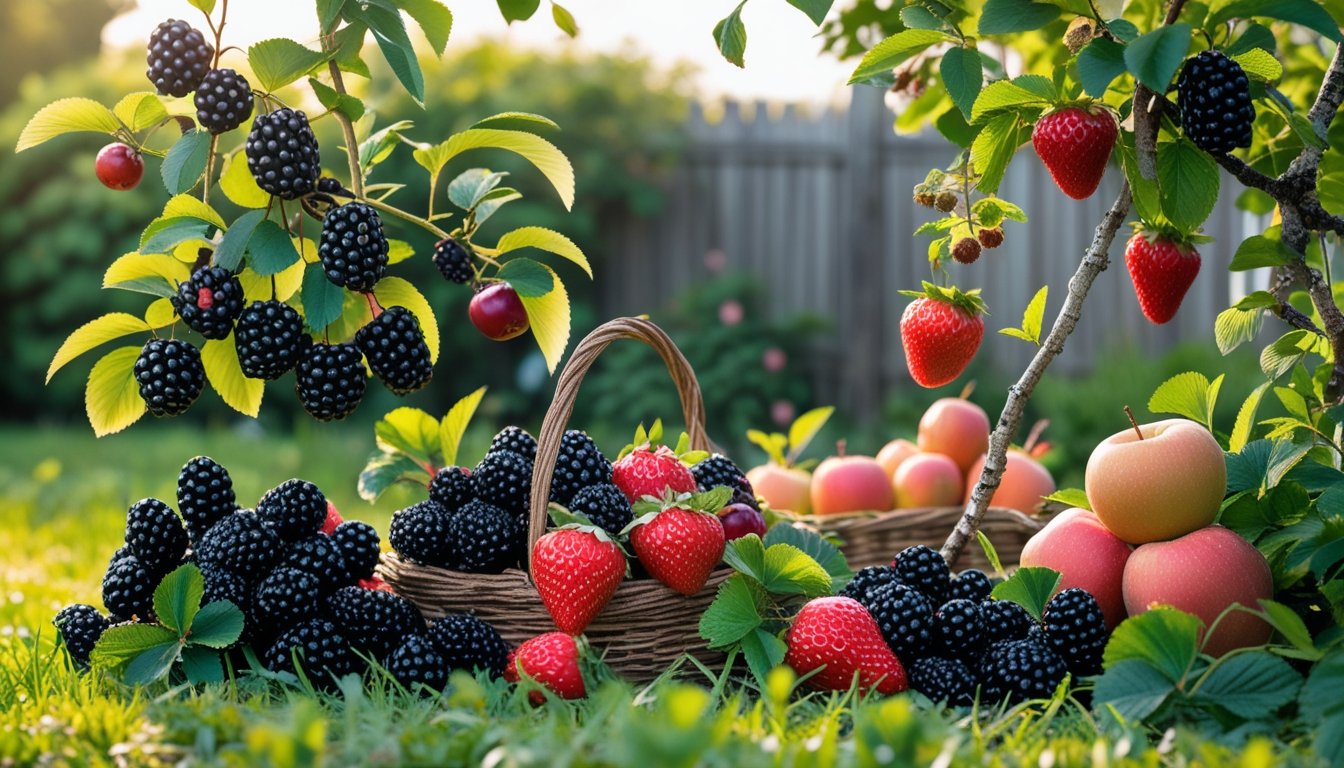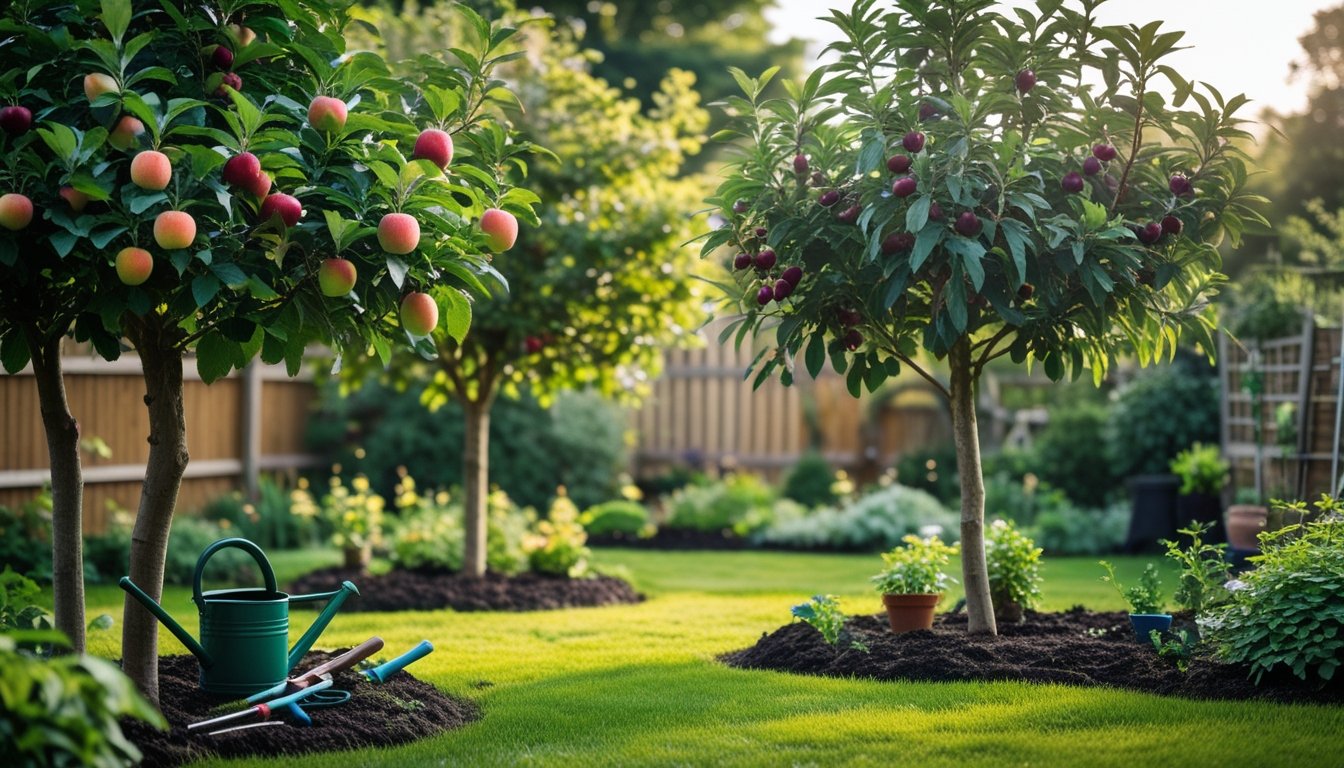Late updated: 02 Nov 2025 09:11
Written by: Emily Thornton
Exploring Native UK Fruit Varieties: A Guide For Your Garden
As gardeners, we can bring the beauty and bounty of native UK fruit varieties right into our backyards. By selecting fruit trees that are indigenous to the region, we ensure that our gardens not only thrive but also contribute to local biodiversity. Many native fruits like apples, plums, and cherries are well-suited to the UK climate, providing gardeners with delicious and sustainable produce.

Native UK fruit trees have evolved over time to withstand the unique weather conditions and soil types of the region. This means they often require less maintenance and fewer resources compared to non-native species. Our exploration of these local varieties reveals a wealth of options, each offering its own distinct flavour and charm, which makes planning a delightful and productive garden both straightforward and rewarding.
Key Takeaways
- Native UK fruit trees are well-suited to local growing conditions.
- Indigenous varieties need less maintenance and resources.
- Planning a garden with native fruits supports biodiversity.
Essential Guide To Native UK Fruit Varieties For Your Garden

Let's delve into some of the most notable native fruit varieties you can cultivate in your UK garden. We'll explore the diverse roles of apples, pears, plums, quince, and cherries in creating a thriving and fruitful garden space.
Native Apple Varieties For UK Gardens
Apples have been a quintessential part of British horticulture for centuries. Our gardens can benefit from growing heritage apple varieties that have adapted well to the UK climate. Notable is the Cox’s Orange Pippin, revered for its sweet-tart flavor and aromatic qualities.
Another favourite, the Egremont Russet, offers a unique nutty taste with a rough skin texture. These apples not only provide delicious produce but also help preserve our agricultural heritage. Proper care, such as ensuring well-drained soil and ample sunlight, is essential for optimal growth and fruit production.
Traditional Pears And Their Role In British Gardens
Pears are another staple in UK gardens, offering both aesthetic appeal and culinary delights. The Conference pear, a popular choice, is known for its long, slim shape and juicy flesh. It's highly versatile, suitable for eating fresh or cooking.
Pear trees thrive in the UK climate, requiring minimal maintenance beyond regular pruning and watering. Selecting the right variety can ensure a consistent yield and bring diversity to our garden landscapes. Positioning pear trees in areas with full sun can enhance their growth and fruiting potential.
Plum, Quince, And Cherry: Expanding Your Fruit Selection
Incorporating plums, quince, and cherries can greatly enhance the variety in our gardens. The Victoria plum is a classic choice, celebrated for its sweet taste and vibrant colour. Plums generally require well-drained soil and benefit from some wind protection.
Quinces, similar to pears but with a distinctive flavour, are making a comeback. They are particularly well-suited to the UK’s temperate climate.
Cherry trees, while requiring careful site selection to avoid frost pockets, can offer both spectacular spring blossoms and summer fruit. By diversifying with these fruit varieties, we can enjoy an extended harvest season and a varied array of flavours in our homegrown produce.
Optimising Planting Conditions And Care For UK Native Fruit Trees

Proper planting and care are essential for nurturing native UK fruit trees. We'll explore optimal soil conditions, crucial maintenance practices like pruning and training, and the importance of biodiversity for a healthy garden ecosystem. A focus on these areas ensures thriving, fruitful trees.
Best Soil And Nutrition For Fruit Trees
Native UK fruit trees thrive in loamy soil, a balanced blend of sand, silt, and clay, known for its ability to retain moisture while ensuring good drainage. Amending the soil with organic matter, such as well-rotted manure or compost, improves its structure and nutrient content. We should aim for well-drained soil to prevent root rot, a common issue in poorly drained areas.
Using a balanced fertiliser helps promote healthy growth, but we must avoid over-fertilising as it can lead to lush foliage at the expense of fruit production. Careful analysis of soil pH and nutrient content informs the appropriate fertilisation strategy. Ideally, we plant in late winter or early spring when the soil is workable and before bud break.
Essential Fruit Tree Care: Pruning, Training, And Pollination
Regular pruning is vital for maintaining the health and productivity of UK fruit trees. It involves removing dead or diseased branches, which reduces the risk of pest infestations. Pruning also allows sunlight to penetrate the canopy, promoting even ripening and stunning blossoms. Espaliers, or training trees to grow flat against a support, optimise space in smaller gardens and enhance fruit-bearing potential.
Our focus on pollination cannot be underestimated, as it directly affects fruit yield. Encouraging local pollinators, by planting nectar-rich flowers nearby, enhances pollination efficiency. Some trees are self-pollinating, but others benefit from cross-pollination, which is why understanding tree variety is crucial in maximising harvest potential.
Supporting Biodiversity And Garden Health
Fostering biodiversity is integral to a healthy garden. By planting a variety of native flora alongside our fruit trees, we create a welcoming environment for beneficial insects and birds. These natural allies help control pests and facilitate pollination. A healthy mix of plant species enhances disease resistance and reduces reliance on chemical interventions.
We can support garden health by employing practices like mulching, which retains soil moisture and suppresses weeds. Introducing predator-friendly habitats, such as bug hotels or birdhouses, amplifies natural pest management. Prioritising biodiversity not only benefits our fruit trees but also cultivates a resilient, thriving ecosystem.
Frequently Asked Questions

Exploring the cultivation of native UK fruit varieties involves understanding which traditional fruits prosper in local gardens and how to maintain them. Native fruits not only offer a connection to cultural heritage but also support local wildlife and thrive in British climatic conditions.
What are some traditional British fruits suitable for growing in a home garden?
In our gardens, we can nurture traditional British fruits like apples, pears, and plums, each offering distinct flavours and histories. Gooseberries and blackcurrants also hold a cherished spot, with their versatility making them popular choices.
Which native fruit varieties thrive in the UK's climate?
By selecting native varieties like the Bramley apple or Victoria plum, we ensure our gardens flourish under typical UK weather conditions. These historical breeds are adapted to the climate, providing reliable yields even in unpredictable weather.
How can one effectively cultivate historical UK fruit breeds in small garden spaces?
For small spaces, we can choose dwarf or espalier forms of native fruit trees, allowing for efficient use of space without sacrificing variety. Container gardening also offers flexibility in tight areas, making it possible to enjoy multiple fruit types.
What care do indigenous UK fruit trees require throughout the seasons?
Fruit trees demand seasonal care to thrive. In spring, pruning helps shape the tree and encourages growth. During summer, regular watering is essential, especially in dry spells. Autumn calls for harvest and preparation for winter. Each season brings specific needs that contribute to a bountiful harvest.
Are there any disease-resistant fruit cultivars indigenous to the UK?
We can opt for disease-resistant varieties like the 'Red Windsor' apple to minimise the need for chemical interventions. Choosing these resilient types helps maintain a healthy garden environment while ensuring a steady fruit yield.
Could you suggest pollinator-friendly fruit plants native to the United Kingdom?
Pollinators thrive in gardens with a range of native fruit plants such as wild cherries and crab apples. These trees not only provide food for us but also support bees and other pollinators crucial for the ecosystem.
